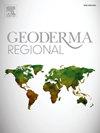原始黑钙土表层有机质转化速度较快,碳保存时间较长
IF 3.1
2区 农林科学
Q2 SOIL SCIENCE
引用次数: 0
摘要
本研究考察了不同土壤类型在不同微地形梯度下的土壤有机碳动态,重点研究了原始黑钙土表层土壤有机碳稳定性和周转率。不同土壤类型间有机碳可分解性(以下称为“质量”或“q”)差异的热力学根源是使用q模型来解释的,该模型将质量视为一个连续变量,而不是假设存在离散的有机碳库。该模型的校准重点是能够有效评估表层土壤(最表层10厘米)的整体有机碳储量和最表层50厘米的总碳储量,同时使用放射性碳周转率作为由于数据可用性有限而可能需要的次要约束。通过模拟土壤有机碳质量分布函数确定的表层土壤有机碳周转时间与类似研究点的经验结果吻合较好,表明表层土壤有机碳周转时间约为6-10年,而深层土壤有机碳周转时间约为数千年。这加强了区分黑钙土表层土壤和底土碳储量及其各自稳定机制的重要性。该分析还强调了土壤温度和水分条件对土壤有机碳(SOC)动态的影响:由于侧向水输入导致的高表土水分水平增加了有机碳稳定性,从而降低了q,因此湿润的地点增加了碳储量。这一结果与现有的腐殖质化理论一致,其中水分可用性是影响有机碳保存和稳定的关键因素。由于温度较低,潮湿的土壤也表现出较少的分解。水分、温度和微生物呼吸速率之间的相互作用需要重新评估不同水分状态下有机碳行为的传统观念,这些观念强调水分对土壤呼吸的影响,而不是有机碳的稳定。这些发现还强调了在寻求优化有机碳保持和整体土壤健康的土壤管理方案中,考虑微地形变化的必要性,特别是在半干旱地区。本文提出的有机碳动态的见解将有助于改善土壤管理策略,从而在不断变化的气候条件下增强各种土壤类型的碳固存。本文章由计算机程序翻译,如有差异,请以英文原文为准。
Faster topsoil organic matter transformation accompanies long-term carbon preservation in virgin Chernozems
This study examines soil organic carbon (SOC) dynamics in different soil types across a micro-topographical gradient, focusing on topsoil SOC stabilization and turnover rates in virgin Chernozems. The thermodynamic origin of differences in SOC decomposability (henceforth referred to as “quality”, or “q”) between soil types is explained using a Q model that treats quality as a continuous variable rather than assuming the presence of discrete SOC pools. The model's calibration is focused on enabling effective assessment of overall SOC stocks in the topsoil (the topmost 10 cm) and the total carbon stock in the uppermost 50 cm while using radiocarbon turnover rates as secondary constraints that may be needed due to limited data availability. The SOC turnover time in the topsoil determined by modeling the SOC quality distribution function was shown to agree well with empirical findings from similar study sites, indicating that SOC turnover times are around 6–10 years in surface layers but millennia in deeper layers. This reinforces the importance of distinguishing between topsoil and subsoil carbon stocks and their respective stabilization mechanisms in Chernozems. The analysis also highlights the influence of soil temperature and moisture conditions on soil organic carbon (SOC) dynamics: high topsoil moisture levels due to lateral water inputs increase SOC stabilization and thus reduce q, so wetter sites have enhanced carbon stocks. This outcome aligns with existing theories of humification in which water availability emerges as a crucial factor influencing SOC preservation and stabilization. Wetter soils also exhibit reduced decomposition due to lower temperature. This interplay between moisture, temperature, and microbial respiration rates necessitates a reevaluation of conventional beliefs about the behavior of SOC in different water regimes that stress the impact of moisture on soil respiration but not SOC stabilization. These findings also highlight the need to account for microtopographic variation, especially in semi-arid regions, in soil management programs seeking to optimize SOC retention and overall soil health. The insights into SOC dynamics presented here will be valuable for improving soil management strategies to enhance carbon sequestration in various soil types under changing climatic conditions.
求助全文
通过发布文献求助,成功后即可免费获取论文全文。
去求助
来源期刊

Geoderma Regional
Agricultural and Biological Sciences-Soil Science
CiteScore
6.10
自引率
7.30%
发文量
122
审稿时长
76 days
期刊介绍:
Global issues require studies and solutions on national and regional levels. Geoderma Regional focuses on studies that increase understanding and advance our scientific knowledge of soils in all regions of the world. The journal embraces every aspect of soil science and welcomes reviews of regional progress.
 求助内容:
求助内容: 应助结果提醒方式:
应助结果提醒方式:


